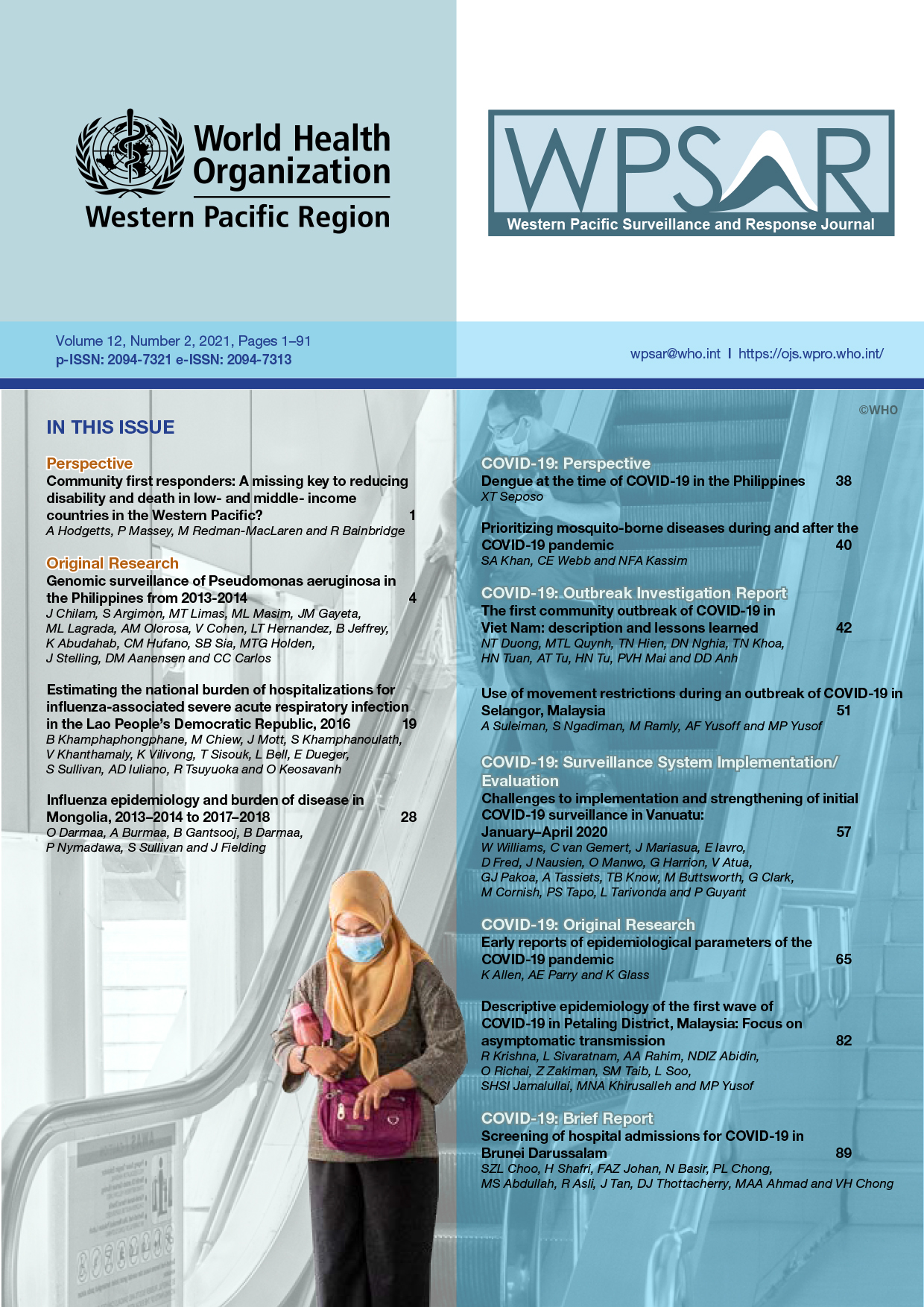Challenges to implementation and strengthening of initial COVID-19 surveillance in Vanuatu: January–April 2020
DOI:
https://doi.org/10.5365/wpsar.2020.11.2.012Abstract
The Pacific island nation of Vanuatu is vulnerable to emerging infectious diseases, including epidemics and pandemics; chronic food and water insecurity; and natural hazards, including cyclones, earthquakes, tsunamis, landslides and flooding. In March 2020, the World Health Organization characterized the outbreak of novel coronavirus disease 2019 (COVID-19) as a global pandemic. By the end of April 2020, Vanuatu had reported no confirmed cases of COVID-19. Data from several sources are collected in Vanuatu’s COVID-19 surveillance system to provide an overview of the situation, including data from case investigations and management, syndromic surveillance for influenza-like illness, hospital surveillance and laboratory surveillance. Review of data collected from January to the end of April 2020 suggests that there was no sustained increase in influenza-like illness in the community and no confirmed cases were identified. Lessons learnt from the early implementation of surveillance activities, the changing landscape of laboratory testing and pharmaceutical interventions, as well as the global experience, particularly in other Pacific island countries, will inform the refinement of COVID-19 surveillance activities in Vanuatu.
References
World Health Organization Regional Office for the Western Pacific. Asia Pacific Strategy for Emerging Diseases and Public Health Emergencies (APSED III): Advancing implementation of the International Health Regulations (2005). Manila, Philippines; 2017.
Coronavirus disease 2019 (COVID-19)Situation Report –101 [press release]. Geneva20 April, 2020.
The Pacific Community. Dr Paula Vivili, Director of SPC’s Public Health division, discusses COVID-19 in the Pacific. 2020.
Vanuatu Ministry of Health. COVID-19 Health Sector Preparedness and Response Plan, v3 (8 April 2020). Port Vila, Vanuatu: Vanuatu Ministry of Health; 2020.
World Meteorological Organization. Tropical Cyclone Harold challenges disaster and public health management 2020 [
Vanuatu National Disaster Management Office. Situation Update 02: Tropical Cyclone Harold 2020 [cited 2020 8/5/20]. Available from: https://ndmo.gov.vu/tropical-cyclone-harold/category/99-situation-update-infograph#.
World Health Organization. Global Surveillance for human infection with coronavirus disease (COVID-19). 2020.
World Health Organization. Laboratory testing strategy recommendations for COVID. 2020.
Kool JL, Paterson B, Pavlin BI, Durrheim D, Musto J, Kolbe A. Pacific-wide simplified syndromic surveillance for early warning of outbreaks. Glob Public Health. 2012;7(7):670-81.
Vanuatu Ministry of Health. Vanuatu Situation Report 3 - 23 March 2020 Port Vila: Vanuatu Ministry of Health 23 March 2020 [Available from: https://covid19.gov.vu/images/Situation-reports/Situation_Report_3.pdf.
U.S Food & Drug Administration. Emergency Use Authorizations. In: Cepheid, editor.: US Food & Drug Administration; 20 March, 2020.
World Health Organization Representative Office for the South Pacific. Novel Coronavirus (COVID-19) Pacific Preparedness & Response: Joint External Situation Report #10 2 April 2020 [Available from: https://www.who.int/docs/default-source/wpro---documents/dps/outbreaks-and-emergencies/covid-19/covid-19-pacific-situation-report-10.pdf?sfvrsn=b1c45d82_6.
Wu Z, McGoogan JM. Characteristics of and Important Lessons From the Coronavirus Disease 2019 (COVID-19) Outbreak in China: Summary of a Report of 72314 Cases From the Chinese Center for Disease Control and Prevention. Jama. 2020.
Kvalsvig A, Telfar Barnard L, Gray L, Wilson N, Baker M. Supporting the COVID-19 pandemic response: Surveillance and Outbreak Analytics. University of Otago Wellington; 20 March, 2020.

